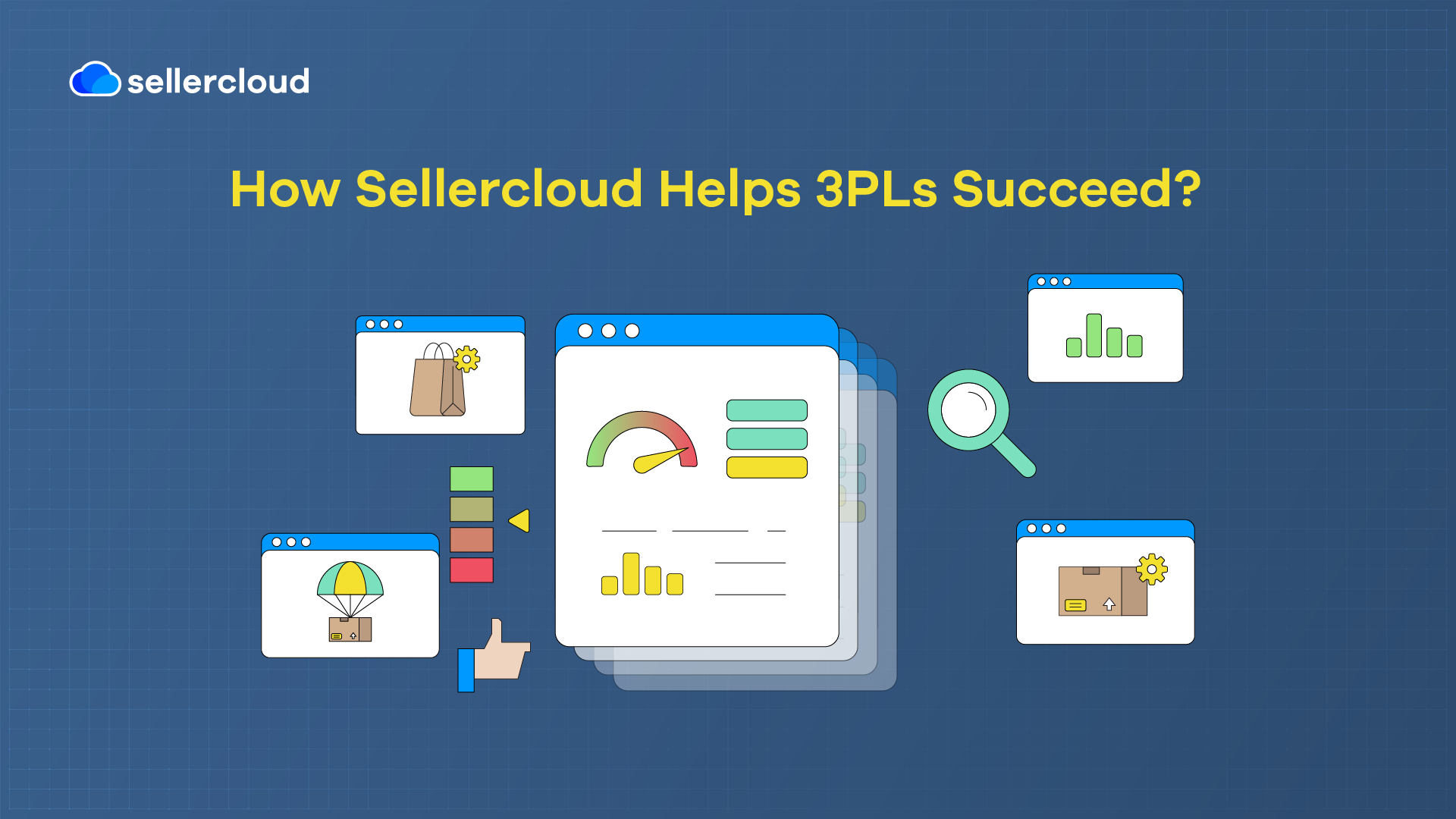
- 3PL companies rely on various tools and features to deliver their services to merchants. These tools help 3PLs improve efficiency, reduce mistakes, and lower costs for them and, ultimately, their customers.
- Descartes Sellercloud has a wealth of features that allow 3PL companies to grow and meet their clients’ needs. Many 3PLs use Descartes Sellercloud to get thousands of orders out the door daily.
There are many opportunities for 3PL companies to grow in 2024. Many businesses expand into ecommerce from retail and wholesale without the necessary resources or expertise. 3PLs have exploded in recent years as logistics and fulfillment costs have skyrocketed since the pandemic.
More and more merchants have opted to outsource their warehousing and fulfillment to third-party logistics companies that have already mastered the warehouse efficiency and shipping optimization required to stay competitive.
According to a report by Mordor Intelligence, the 3PL market is estimated to reach $1.29 trillion in 2024 and $1.68 trillion in 2029. However, the 3PL industry is now more competitive than ever. To stay on top, 3PLs must have the right software with all the tools and features to provide their clients with the best service possible at the best rates possible.
In this article, we’ll examine the most vital features a 3PL company must have to choose the right software solution to grow its business.
13 Most Important Features and Tools for 3PL Companies
3PL companies armed with these features are well-positioned to grow substantially.
1. Warehouse Management System (WMS)
Using a WMS is an absolute must. According to sources, approximately 85% of warehouse operations use a WMS. You should use a good one to keep up with the efficiency of other 3PLs. A WMS keeps you organized, dramatically improves efficiency, and streamlines operations from one step to the next. Using a WMS that integrates with the rest of your software is also a must.
Solution: Skustack is Descartes Sellercloud’s WMS module and mobile scanning app. Warehouse workers can scan products to pick, orders to verify, POs and RMAs to receive, conduct cycle counts, and assemble bundles. Skustack tells them exactly where and what to scan, reducing mistakes and picking times.
Skustack can give 3PL customers visibility into day-to-day operations and provide information on specific orders and metrics. However, what really makes Skustack stand out is that it was built as an extension of Descartes Sellercloud. It was not acquired from another company and integrated; it was built to work with Descartes Sellercloud. This also means Descartes Sellercloud and Skustack share the same database; there is no real-time data-sharing lag.
2. Integrated & Automated Shipping Solution
Manually rate shopping for each order and shipping label is excruciatingly time-consuming and can mean spending money on time spent rate shopping or missing out on the best rates to keep your shipping costs down.
Having the right shipping solution connected directly to the channels and the shipping provider allows you to automate the time-consuming parts of the shipping process, including dimensional data, rate shopping, label printing, and tracking upload.
Solution: Shipbridge is a free shipping tool for Descartes Sellercloud users. It enables businesses to manage their shipping providers, labels, invoices, packing slips, EOD reports, third-party shipping accounts, and more.
3. Sorting System to Prevent Errors
Orders get out the door and reach consumers faster when you have efficient sorting processes that allow employees to spend less time sorting products without sacrificing fulfillment accuracy. An efficient sorting tool will mean fewer labor hours spent sorting products, and employees can get more done in fewer working hours. It also means no mistakes, fewer returns, and fewer customer service complaints.
Solution: Skublox is an order sorting tool. Using light boxes, Skublox guides employees to the right bins when sorting products. Skublox can also be configured to create virtual walls and set up mobile carts, allowing you to sort orders as you pick them, saving time and money by eliminating the need for a sorting station.
4. Reporting and Analytics
There are many reporting features that 3PL companies rely on to manage their business. Reports are used to make internal data-driven decisions and for external reporting requirements. This is a regular occurrence when providing fulfillment services to customers who rely on you to manage an important part of their business. The more reporting features 3PLs have available to them, the better.
Solution: Descartes Sellercloud’s reporting and analytics features cover various ecommerce purposes, including shipping, workforce, inventory, warehouse movements, and even custom reports. 3PLs can even offer their customers a portal for real-time visibility on every product, order, and shipment.
5. Multiple Warehouses
Your 3PL company may have different warehouses for different purposes, some in other parts of the country or the world. Surprisingly, many solutions do not support multi-warehouse management or the ability to divide your inventory across warehouses.
While this might not be an immediate requirement, it is necessary if you want to offer one- or two-day shipping around the country or if you have plans to grow to a point where that can be offered to customers.
Solution: Descasrtes Sellercloud’s modules support businesses that use multiple warehouses, so you can easily manage them wherever they are located and transfer, divide, or manage your inventory between them.
6. Warehouse Regions
Your solution should enable you to drill down into specific areas of your warehouse, including warehouse regions, which you may use for different clients or purposes. It should allow you to filter picklists by region so pickers don’t get in each other’s way, and so pickers don’t wander aimlessly; instead, systematically picking items in a given region before moving to the next. This saves time and increases warehouse productivity.
Solution: Skustack helps you break your warehouse into regions and filter picklists by region. It’s also worth noting that many solutions use ‘wave picking,’ where pickers pick from one end of the warehouse to the other. Skustack is more flexible and does not limit how you pick products.
7. Order Tracking
From the moment an order is placed until it reaches the customer, a 3PL must be able to track and manage the order and be aware of any issues. 3PL software solutions must be able to download orders, track the order status while it is picked, packed, or shipped, and share the order tracking information with their client and sometimes even the marketplace or channel on which the order was placed.
Solution: In Descartes Sellercloud, you can set up multiple companies to manage your customers’ fulfillment requirements individually. Each company in Descartes Sellercloud can be configured with its own integrations and products, keeping order information separate.
Furthermore, with Descartes Sellercloud, you can connect multiple different Amazon accounts for hundreds of clients. All client orders will come into Descartes Sellercloud. You can filter orders by company, so you can ship one client’s orders and then the next, not accidentally mix client inventory, and track orders more easily.
8. Overviews and Workforce Management
With an overview of your workforce and what they are up to, you can find ways to optimize their productivity. If your workforce isn’t efficient, it affects orders for all your clients, and that’s bad news. Additionally, less time spent fulfilling orders saves your business money on labor expenses and makes the fulfillment speed you offer your customers more attractive in the competitive market.
In a large warehouse, it’s impossible to be everywhere at once. But with the right workforce management solution, it’s easy to know exactly where every employee is and what they are doing.
Solution: Skustack Lens allows you to track employee activity and tasks in real time. Tracking every scan in the warehouse also provides employee time logs, enabling you to see who picked what, when, and why. For example, who shipped, moved inventory from A to B, and received a return.
Expanding on picking, Skustack Lens can show you the route an employee took, the steps they made, and how much they picked per product, and it provides a real-time dashboard with all your picklists and their progress.
9. Warehouse Visualization
Warehouse visualization is essentially a digital overview of your warehouse that shows you what’s happening. You don’t have to be on the warehouse floor to know what’s where and what is happening in any given area.
For example, it can show you where your staff is as they move around the warehouse. It also enables you to search bin and rack contents and products in a visual representation, making it easy to locate bins or their products with a simple search.
Solution: Skustack Lens allows you to do all the above. It also allows you to better organize and monitor inventory as it moves through the warehouse and plan for picking and receiving.
10. Inventory Updates
A 3PL must know when new inventory is needed and when it will arrive from clients. This should be a fluid transfer of inventory information, enabling them to sync with their customers and to prepare efficiently.
Solution: As with order tracking, Descartes Sellercloud segregates your client information within your account. Inventory updates can be sent and received to vendors, customers, and channels without information mixing between your clients, making it easier to manage inventory changes and the replenishment workflow with your customers.
11. Multiple Channel Integrations
Integrating whatever services your 3PL company needs to send and receive information shouldn’t be challenging. You should receive a constant stream of orders from your clients. Many ecommerce businesses are omnichannel and sell across several marketplaces and other channels, so a 3PL service must be able to connect to these channels to download orders, sync inventory, and upload tracking, at the very minimum.
3PLs should not have to check every client and channel individually. It wastes time and increases the likelihood of mistakes. It is optimal to have one place where orders are received and managed, regardless of where they came from and where they are going.
Solution: Descartes Sellercloud has 350+ integrations and can create custom plugins to connect any external services you need through EDI or their web service API. The best thing about using Descartes Sellercloud for your 3PL business is that you can receive automatic updates and fulfill orders immediately, and the client doesn’t have to do a thing.
12. Ship to FBA for Customers
3PLs handle many client responsibilities. For them to be effective, they need to be able to access the services clients use to fulfill orders. Amazon orders make up a significant portion of ecommerce orders, and supposedly, up to 82% of Amazon sellers use FBA as their primary fulfillment method. 3PLs should be able to make shipments in clients’ names to ship items to Amazon’s fulfillment centers (as well as other fulfillment options, such as Walmart’s WFS).
Solution: Descartes Sellercloud’s FBA integration enables 3PLs to easily fulfill orders and gain visibility into what is happening. It’s also worth noting that Descartes Sellercloud is an official Amazon software partner.
13. Optimal Warehouse Efficiency to Compete
Improving efficiency in parts of your warehouse processes can have a knock-on impact on your ability to fulfill orders faster and give you an advantage over your competitors. Optimizing warehouse efficiency can mean making things easier and faster while minimizing the potential for mistakes.
Solution: Hardware and software solutions can improve warehouse efficiency for different fulfillment tasks. For example, Descartes Sellercloud’s 4D Scale measures and weighs packages to help you get the best prices for your orders. The 4D Scale saves package weight, and information can be shared with different devices.
5 Best 3PL Software Solutions for 2024
There are some genuinely great 3PL software solutions available these days. Ensure you research before implementing a solution you might not be happy with or, worse, unable to scale with your business!
1. FarEye
FarEye is headquartered in Chicago, Illinois, and was founded in 2013. It focuses on last-mile delivery and has over 150 customers in over 30 countries.
Strengths
FarEye is highly rated on G2, with 4.7 out of 5 stars out of 155 reviews. What makes it really stand out is the logistics visibility it provides, with supposed AI-driven optimizations for real-time tracking and delivery.
Weaknesses
Despite the good reviews, many users have reported technical issues, and some have said FarEye is not easy to use. Furthermore, it lacks advanced order and inventory management features.
How Does FarEye Compare with Descartes Sellercloud?
Descartes Sellercloud is a much broader ecommerce solution offering order and inventory management and hardware for sorting, picking, and weighing orders. Furthermore, FarEye’s pricing starts from $100,000, while Descartes Sellercloud’s pricing is per order.
2. ShipHero
ShipHero fulfills over $5 billion worth of annual ecommerce orders. It is headquartered in Garnerville, New York, and was founded in 2013.
Strengths
Great option for DTC brands looking to improve warehouse management and order fulfillment. ShipHero offers a streamlined workflow, rule-based business logic, and various automations.
Weaknesses
ShipHero lacks certain capabilities that some 3PLs may desire. For example, their sorting system is to ‘lock’ a total per order, which is very inefficient. ShipHero is also not transparent about its pricing and has only a few marketplace integrations.
How Does ShipHero Compare with Descartes Sellercloud?
Descartes Sellercloud excels in multichannel selling, offers a free shipping solution (Shipbridge), and integrates with the sorting solution Skublox. Additionally, Descartes Sellercloud supports sophisticated inventory and order management and has more integrations.
3. Logiwa WMS
Headquartered in Chicago, Illinois, Logiwa was founded in 2017. It is mostly used for its warehouse management system.
Strengths
Easy to use and customizable, unlike most alternatives, Logiwa WMS offers advanced inventory control, order fulfillment, and real-time data analytics. It is an ideal choice for high-volume warehouses.
Weaknesses
Primarily a WMS, Logiwa WMS has limited functionality beyond warehouse management. On top of that, Logiwa WMS’s pricing model is also not transparent.
How Does Logiwa WMS Compare with Descartes Sellercloud?
Descartes Sellercloud offers more integrations and is a more robust solution for 3PL businesses. Not only does Descartes Sellercloud cover inventory and order management, but it can also connect 3PLs to many other services they’ll need outside the warehouse.
4. ShipBob
Headquartered in Chicago, Illinois, and founded in 2014, ShipBob supports over 7,000 ecommerce brands.
Strengths
ShipBob is a good choice for small to medium-sized 3PLs as it has good warehousing and shipping features. It is also known for quick delivery.
Weaknesses
Unfortunately, ShipBob relies on its own network of fulfillment centers. This means that it is not as flexible as other options, which is paramount to 3PLs.
How Does ShipBob Compare with Descartes Sellercloud?
3PLs will have far more flexibility with Descartes Sellercloud as it allows them to use their own fulfillment methods. Descartes Sellercloud also offers inventory and order management features.
5. ShipMonk
ShipMonk was founded in 2014 and is headquartered in Fort Lauderdale, Florida. It currently has approximately 1,000 customers.
Strengths
ShipMonk is good for businesses of all sizes and is designed to be easy to use. It is also a good option for 3PLs looking for automation and wanting to scale their business.
Weaknesses
3PLs may find that ShipMonk lacks advanced in-house inventory and order management features. Some businesses have complained about losing SKUs and that leaving ShipMonk can be difficult.
How Does ShipMonk Compare with Descartes Sellercloud?
There are limitations to ShipMonk’s customization, while Descartes Sellercloud thrives on customization. 3PL companies using Descartes Sellercloud can also manage inventory across multiple warehouses and operate more efficiently across multiple channels.
How Descartes Sellercloud Helps 3PLs Succeed?

Descartes Sellercloud and its ecosystem offer a wealth of features to support 3PL companies and help them overcome many of the common challenges they encounter.
Some of Descartes Sellercloud’s 3PL customers initially started as ecommerce sellers before realizing Descartes Sellercloud’s potential to support 3PL operations, just like ShipFlow. “I don’t think I would be able to run a 3PL or even run my own brand without Descartes Sellercloud. We have a great partnership with them,” says Ezra Avidan, co-founder and CEO of ShipFlow.
With Descartes Sellercloud, you get all the functionalities you need to improve your 3PL business efficiency, allowing you to focus on other aspects that promote growth. “With Sellercloud, my employees are able to do what they’re good at—doing picking, packing, shipping—while it allows us to be outside of the business focusing on the growth,” says Marc Furmanski, Part Owner of MP Fulfillment.
Descartes Sellercloud is also highly versatile and can be customized to your needs, helping your 3PL work the way you need it to, not the other way around. For the 3PL companies that have adopted Descartes Sellercloud, its ability to adapt to whatever customers need it to do has enabled them to take on more merchants and offer them features most 3PLs can’t.
“Sellercloud has helped us in growth in terms of being able to bring in new merchants, who require not only an enormous amount of customization, but also, you know, different types of features that they just normally wouldn’t get with other types of software,” said Caleb Lee, CEO of Powered by Fulfillment
Watch below how Descartes Sellercloud’s customization made it the backbone of Powered by Fulfillment’s 3PL operations, allowing them to create custom solutions for all their clients.
Book a Descartes Sellercloud demo today to learn how we can support your 3PL business.
Key Points
- Essential features a 3PL software solution needs to offer are WMS, shipping provider integrations, sorting, reporting, inventory updates, order tracking, and workforce management.
- Descartes Sellercloud’s ecosystem comprises tools and products that tackle different challenges and processes for running an ecommerce business.
- The best 3PL software solutions are Descartes Sellercloud, FarEye, Logiwa WMS, ShipBob, ShipHero, and ShipMonk.
- Descartes Sellercloud can take your 3PL business to the next level through automation, acting as the nucleus of your company where all information is fed and managed.




